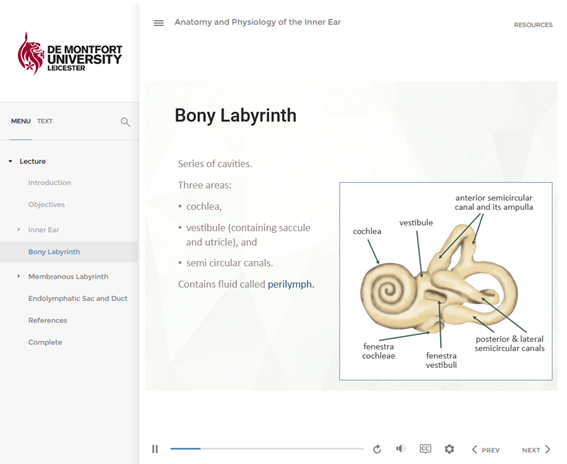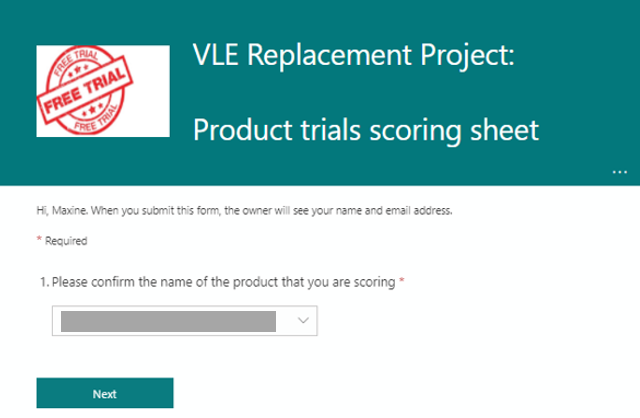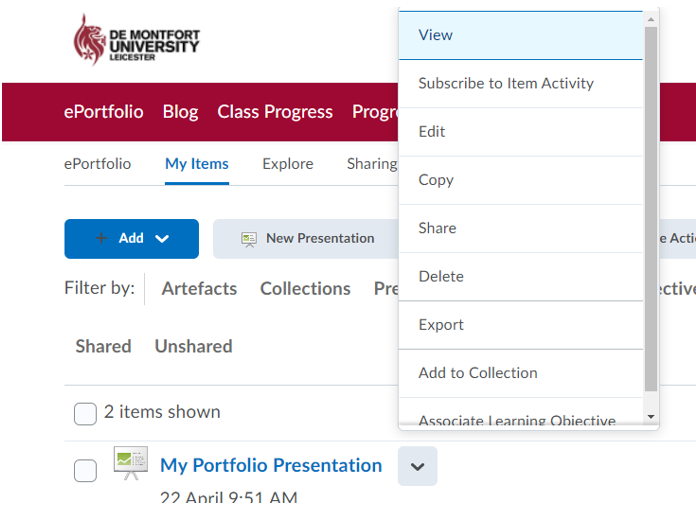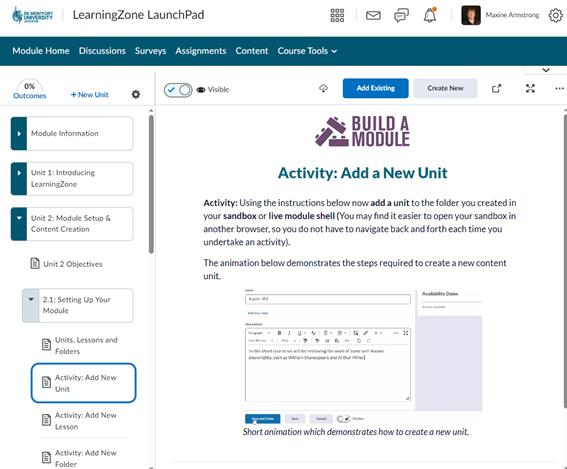I have used a variety of learning technologies over the nearly 30 years that I have working in higher education. These include: Blackboard, Turnitin, Campus Pack, Articulate Storyline, Articulate Rise, Panopto, WordPress and the Xerte online Toolkit. These technologies have enabled me to develop a variety of learning resources for online and distance learning students, such as: blogs, wikis, journals, discussion forums, narrated presentations, phase tests and knowledge tests.
a) An understanding of the constraints and benefits of different technologies
De Montfort University is in the process of changing its virtual learning environment (VLE). The current VLE, Blackboard, is due to be decommissioned in December 2023, therefore the university has been going through a procurement process since May 2021. The new VLE LearningZone, will be available from the start of the academic session 2023/24 for the majority of the university, although a number of pilot modules have been running since January 2023.
I was part of the procurement workstream that reviewed the technical and functional capabilities of the competing VLEs tendered. In February 2022, the four VLE tender finalists demonstrated their products, and I was part of the panel that evaluated them. After reviewing the four VLEs that reached the final stages I was again part of the team that then trialled them, in March 2022. As part of the Digital Learning and Teaching (DLAT) team, we developed a series of user journeys for students, staff and administrators, that formed the basis for these trials.
Because a VLE can combine a number of different tools and features, we had to consider the constraints and benefits of a range of functions and prioritise them according to the needs of the multiple stakeholders – that included students, academic staff and administrators. This led to a very long list of requirements which then had to be streamlined down to a feasible decision analysis. The pedagogical affordances of each tool or function was of prime importance.
So far, the new VLE appears to be popular with students and a full review is now ongoing to see if the selected product met the procurement requirements.
I learnt a lot from being part of the trial team in understanding how to compare different technologies when procuring new technologies.
From the procurement process I learnt how complex these decisions are, and that ultimately procuring any technology has to be a compromise, due to the conflicting demands placed on any large technological project. The functional build and pedagogical uses of the technology only fulfilled one part of the contract and the commercial and legal obligations were immense.
Initially, the user journeys we created were helpful in providing a level playing field to compare all four products tendered to ensure they fulfilled the requirements of the decision analysis.
However, what we have since discovered is that the user journeys did not cover all the nuances that were needed. Our stakeholders are far more diverse than the user journeys demonstrated and therefore there were a number of gaps. Now that the VLE is being implemented we are discovering that it does not exactly meet the pedagogical needs of our students and that numerous workarounds are necessary.
Portfolios are one area where a workaround will probably be required. Our previous VLE, Blackboard had no portfolio feature – so although this was a feature considered beneficial it was not regarded as a ‘must-have’ for the new VLE. In April 2022 we conducted testing of the portfolio feature in all four tenders.
Although portfolios were part of the tendering process we have since learnt that the eportfolio feature in our new VLE is being decommissioned and the new portfolio tool does not have as many features. This shows a shortcoming in the procurement process and we are now looking at ways to work around this deficiency.
Reflecting on the procurement process in retrospect, although it was not possible to use the full wish list of requirements to create the decision analysis, I think that we needed to develop the user journeys more, to ensure they captured more detail to enable the functional and pedagogical review of the VLEs tendered to be more effective.
b) Technical knowledge and ability in the use of Learning Technology
As previously mentioned, I have worked on a number of past projects that have used a range of learning technologies, such as Campus Pack, Turnitin, Collaborate, Panopto, Articulate 360, Xerte and Teams. Arguably the most important technology for learning is the virtual learning environment (VLE) and at DMU we have previously used Blackboard Learn as our main platform. Since January we have been piloting Brightspace from D2L, badged as LearningZone, and it will go live for the rest of the university from October 2023.
I have supported the development of the Hearing Aid Audiology programme since 2013, creating many learning resources for the academic team and setting up their Blackboard module shells. I am now in the process of migrating their modules from Blackboard onto LearningZone for the current cohort and for the new cohort that will be starting in October 2023. As well as the standard learning resources, such as Word documents, there are additional specific resources, such as video recordings in DMU Replay (provided by Panopto).
The learning resources for these Hearing Aid Audiology modules include a number of Articulate Storyline 360 SCORM packages that were originally created from PowerPoints containing spoken narration. These Storyline resources replace earlier synchronous lectures, since this is a distance learning programme.

The modules also include video recordings, phase tests, discussion boards, Turnitin assessments as well as the mandatory reading.
As well as using the tools and features of a VLE I have experience of using other learning technologies outside of a VLE. I have used Xerte Online Toolkit as a means of creating learning resources for distance learners. I installed Xerte Online Tools on a server at the university (the server has been set aside for academics to use to create independent learning objects). Another tool I have used is WordPress. In particular, I have used the DMU’s WordPress site, OurDMU, as a blog and website to create and provide guidance for staff:
- Blog posts published by Maxine Armstrong – DLaT Hub (dmu.ac.uk)
- Profile of Maxine Armstrong – DLaT Hub (dmu.ac.uk)
- https://celt.our.dmu.ac.uk/using-the-virtual-computers-and-desktop-during-synchronous-sessions/
I also created websites for projects that have not been able to use the universities VLE. For example, I was instrumental in the development of the eParasitology, Learning Resources for the Study of Parasites website, which was created using Bootstrap templates.
On reflection, it has been a very useful exercise to migrate the Hearing Aid Audiology modules from one VLE to another because I am now more aware of the processes that all the university academics are currently going through as they transition to the new VLE. It has provided me with a greater understanding of the time it takes, what works well and what needs more attention. Although module content was migrated over centrally to the new VLE, it is not possible to migrate all content such as the DMU Replay recordings, Turnitin assignments and SCORM packages. I have discovered that adding these manually is more time-consuming when you are using a new system and more testing needs to be done to ensure they appear as you expect and capture the results you expect.
Initially the SCORM Phase Tests we created for Hearing Aid Audiology (HAA) worked well, but when the course subsequently became an apprenticeship, the module team needed to capture more data about from test submissions. This data could not be extracted from the SCORM packages as we do not have a data server. Therefore, I had to abandon the SCORM tests and redo them directly in Blackboard. Now that we are moving to a new VLE I will have to re-do them again. (If I had been able to utilise Xerte I would not have had to re-do them as we would have been able to capture the data we needed on the Xerte server.)
By supporting the HAA academic team with the migration, I have ensured that the students have the best learning journey we can give them as they transition from one VLE to another.
c) Supporting the deployment of learning technologies
As previously mentioned DMU is in the process of transitioning to a new VLE. My involvement in the procurement process extends into the early phases of deployment of the new VLE, LearningZone (provided by Brightspace).
There were a number of modules piloted in January 2023 and I provided advice and support to the Postgraduate Clinical Pharmacy programme that was part of the pilot.
Currently we are in the transition phase where staff are familiarising themselves with the new VLE. During this transition the DLAT team is providing additional training sessions and support to help all staff make the switch. I have been facilitating sessions such as the ‘Build A Module’ workshops that were run as face-to-face sessions up until July 2023. Over summer 2023, these sessions are running everyday online so that staff who are not on campus can also access the training.
The DLAT team also created a self-directed module called LaunchPad, that is compulsory for staff. LaunchPad is a self-taught module in LearningZone that teaches staff how to use LearningZone. Staff are encouraged to work through the module to prepare their programmes for students in readiness for the changeover at the start of the new academic year.
To ensure that students have a consistent learning experience LaunchPad uses DMU threshold standards that are based on the Quality Matters HE standards rubric.
Although the LaunchPad module was developed collaboratively, I wrote the unit on ‘Module Set-Up and Content Creation’. I ensured this unit included activities that walked each user through setting up their module and adding various types of content – from videos to PowerPoint slides and using HTML templated webpages. I added concise explanatory animated gifs where tasks were short, and longer step-by-step written and graphical instructions where more detail was necessary.
Taking part in the procurement process showed me that the functional aspects of a product only played a small part in the decision analysis. Deploying a large learning technology within a university is a complex and expensive exercise that brings together people from all the faculties and many different professional services within the institution. A number of workstreams were created for deployment and I have worked with three of them: the Functional Build workstream, the Technical Build workstream and the Training workstreams.
The Build a Module workshops have been popular and I have enjoyed helping my colleagues gain confidence in using LearningZone.
With so many different areas of the university involved in the training, it has been difficult to coordinate training and more collaboration earlier on in the deployment would have been helpful.
As governance and policies for the new VLE have been developed whilst training was ongoing, sometimes I have been unable to answer queries and it is frustrating to have to respond to colleagues’ queries by saying we have to wait and see.
If I was involved in the deployment of a large-scale learning technology in future, I would ensure I was better prepared, for example by ensuring I was clearer on the scope of the project and the individual responsibilities of each workstream. I would also encourage strong communication channels between everyone involved.
Providing this support has had a positive impact on my academic colleagues who have shown an increase in confidence in using the new VLE knowing that support is available. This has encouraged them to try the more interactive elements of the VLE that has daunted some in the past.



